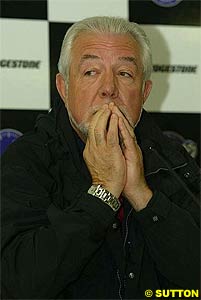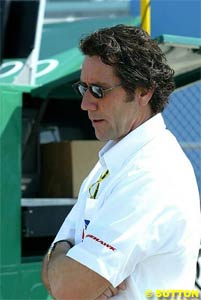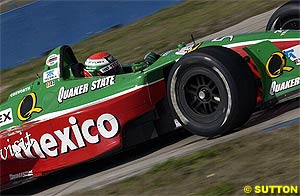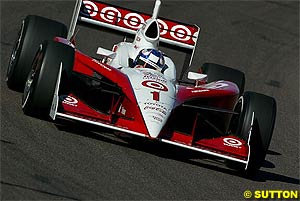
Contributing Writer
Not so long ago, CART was seen as a genuine rival to Formula One in more ways than one. The racing was thrilling, the stars were big and the money was pouring in. But somewhere it all went wrong. Caroline Reid charts the fall from grace of one of the world's premier racing series.
The ruling came at 4.57pm, to an audible sigh of relief from the gallery packed with CART employees. The prime assets of the bankrupt CART Champ Car series were awarded to the Open Wheel Racing Series organisation, a consortium of team bosses led by Gerry Forsythe. Tony George of the rival Indy Racing League series and the Indianapolis Motor Speedway had failed in his bid to reunite American single-seater racing. Champ Cars had lived to fight another day.
It was only a decade ago that CART had it all. It was a genuine rival to Formula One. Between 1993 and 1994, its top drivers included Emerson Fittipaldi, Mario Andretti, Nigel Mansell, Nelson Piquet and Jacques Villeneuve. In the winter of 1992 Ayrton Senna tested for Penske with a view to racing for them in 1993 instead of for McLaren in Formula One, and this was at the height of his career. In comparison, between 2003 and 2004 the biggest names in Champ Cars are Paul Tracy, Sebastien Bourdais, Bruno Junqueira, Jimmy Vasser and Mika Salo. A list of talented drivers, but it does not read like a Who's Who of motor racing.
The Split and the IPO
The beginning of CART's Road to Hell can be traced back to 1996 when the CART Champ Car series and the new Indy Racing League parted ways. IRL was run by Indianapolis Motor Speedway owner, Tony George, who wanted a bigger share of the profits. Initially IRL was the poor relative of CART, even though it had sole use of the legendary Indy 500 owing to a CART boycott of the event. The great race was devalued in the eyes of many as there were few star drivers competing, while CART had a respectable pulling power. However, George had a vast family fortune to fund his enterprise, whereas CART was more reliant on fluctuating financial conditions.
Bobby Rahal took over temporarily as chief executive while a replacement for Craig could be found. CART's problems continued, but it seemed as if the ideal top man had been found in the form of television executive Joseph Heitzler, who took control at the end of 2000.
CART's main problem at this stage was the sliding television viewing figures combined with often poor quality footage of the races. This meant that CART's drivers had poor name recognition among the general public and sponsors were complaining about not getting their money's worth. Heitzler's background seemed perfect: he was an experienced television sports executive whose most recent job had been as president of National Mobile Television Productions, which provided mobile production facilities for some of America's top sporting events.
Heitzler headed CART for a year exactly. During that time the viewing figures slid further. Several teams began to contemplate moving to IRL and eventually Penske did. Penske's loss was inconceivable: Roger Penske was one of the series founders and his team the most famous and successful in the series. September 11 had also hit sponsorship revenues, plunging the series and some of its teams into further woes. Heitzler had failed catastrophically. The share price on the final day of his spell in charge was a mere $15.
Pook Takes the Reigns
So at the end of 2001 in came Chris Pook, the English-born Long Beach Grand Prix promoter who had wanted the job for several years and was a respected figure in American motor racing. He was seen as the saviour of CART and there were high expectations of what he could do. He was awarded a half a million dollar salary to get the job done.
But by mid 2002 there were no improvements, in fact the opposite. In response, the CART board came up with a radical plan to attract teams to the series. In 2003 each car entered in the series would be provided with $850,000 in cash by CART, which would be funded by CART selling space on the cars to associate sponsors of the series. In addition to this Cosworth would become sole engine supplier of the series and a scheme would be instituted whereby CART would buy 100 engines from Cosworth for $4 million to sell to the teams at a cost of $100,000 per year per car over the next two years. CART would also provide on-track engine support costing $750,000 per year.
But somehow the maths didn't add up. CART expected 20 cars to compete in the 2003 championship. This equated to $17 million per year in the Entrant Support Program. For two years' worth of engines, CART would receive back its $4 million, providing that 20 cars competed each season and even at that stage this was looking unlikely. The additional engine support would cost another $1.5 million. Pook's new measures had delivered CART costs of almost $40 million over the next two years, with only a few million certain to be paid back. He expected that the cash in the bank would pay for it initially, and that the changes would bring around new investment to fund the series after that.
The measures were not enough even to keep the teams in the series. A month later, Andretti Green, one of the top teams, defected, taking established drivers Michael Andretti, Dario Franchitti and Tony Kanaan with it. CART also reported losses of $17 million and $16 million in the last two quarters of 2002. Title sponsorship from Ford and Bridgestone was a bonus, but was still a mere drop in the ocean.
Wall Street was mystified by the payments to the teams, especially to Derrick Walker. No one from CART was willing to comment on the payment, save for hints that it was related to the fact that Walker had a seat on the CART board. CART insiders pointed out that no one complained when Tony George spent several millions of dollars on IRL, but that was somewhat missing the point. It was George's own money and not the shareholders' that he was parting with. CART said that if it spent $15 million a quarter it would last well into 2004 even if no more money came in.
Soon CART was boasting that it had received worldwide television audiences an average of nine million for the first five races of the season. It was nothing to boast about. A Formula One race can command that kind of audience in a single European country. CART insisted that Pook would stay until his contract ran out at the end of 2004 at least, and he had many supporters who felt that no one else could have done better.
In mid 2003 CART was forced to issue financial guidelines on how it planned to turn things around. One alternative was the sale of the company to private investors, and Gerry Forsythe's name was already being mentioned. CART identified three main areas as the reasons for its losses: the fact that it had taken on the promotion of six races itself, making a loss of around $3.1 million on the first two such events alone, plus a reduction in sanction fees; its inability to negotiate a domestic TV contract that had led to CART paying the networks to show the series at a cost of around $16 million, of which only a quarter was returned in advertising; and the difficult economic climate that had led to sponsors pulling out or reducing their expenditure.
Open Wheel Comes onto the Scene
The announcement wiped $50 million off the value of the company. More gloomy statements followed. By mid August a company called Open Wheel Racing Series LLC had been formed by team owners Forsythe, Paul Gentilozzi of Rocketsports and Kevin Kalkhoven of PK Racing (co-owned by Craig Pollock) with a view to buying CART. OWRS offered to buy all outstanding shares at 50 cents each, after snapping up roughly 23 per cent of the shares itself. The CART board agreed in principle to the offer.
Some insiders still praised Pook. They argued that without him there might not have been a CART to sell, that he had improved racing (albeit without improving audiences) and that he had prevented CART from becoming a mere off shoot of IRL. It was pointed out that the board was made up of experienced executives who could have over-ruled him at any time if they felt the need, and that he had managed at last to suppress the power of the teams. It was said that he had at least guaranteed the shareholders a little cash return.
Except he hadn't. It became clear that there was a problem when early last December it was announced that the first race of the 2004 season had been cancelled. Then, just before the meeting when the shareholders were expected to approve the 56 cents per share deal, OWRS pulled out. OWRS claimed that its conditions had not been met by CART because there would not be enough teams to compete in the 2004 series, although the team owners were all capable of fielding more cars themselves. CART filed for Chapter 11 bankruptcy. This paved the way for OWRS to buy whatever assets of the series it wanted, while the shareholders were guaranteed nothing.
OWRS was willing to purchase the following assets: all the promoter contracts; the Ford and Bridgestone title sponsorship contracts; the Cosworth engine contract and the related team engine lease contracts; and the Brazilian and Mexican television rights contracts. The stock of Pro-Motion Agency, the subsidiary that ran the Toyota Atlantic feeder series, would also be part of the deal. OWRS expected to purchase these prime assets for around $3 million, rather than the $7.5 million it would have cost to pay off the shareholders, minus the $1.5 million in prize money owed to the non OWRS teams.
The IRL twist
But there was another twist in the tale. In mid January, Tony George revealed that IRL was to put in a rival bid for CART's assets and thus create an American single-seater super series running on both ovals and road courses and with the Indy 500 as its showpiece event.
In the end Judge Frank Otte chose to save the series. CART had requested that he do so and promised to write off certain debts if the series went to OWRS. George had argued that as many of the CART races were loss making, it was not detrimental to them to lose the race in 2004, but he lost anyway. He remained upbeat that some day soon open wheel racing would be united once more.
OWRS were delighted, and put together plans to run 18 cars for 15 or 16 races across the globe in 2004. The CART employees and promoters were happy because they had kept their jobs and revenues. But the losers in all this were the shareholders who had seen their investment come to nought.
The Future
So CART is dead, but Champ Cars lives to fight another day. But the problems are far from over and OWRS will find itself facing the same obstacles that had beset CART, including low TV audiences and defecting teams. Running OWRS Champ Cars even in its most basic form will cost around $50 million this year and there is nothing to stop more teams defecting to the greater stability of IRL. It could be that a year hence everyone involved will be facing a very similar situation, and in that instance there may be nothing to prevent Tony George from expanding his empire.
That may be bad for CART, but would it be bad for motorsport? Probably not. The reunification of CART and IRL would create an American super series chasing after the glories of the early 1990s, making inroads into the audiences of NASCAR and eventually maybe even Formula One. The top teams and drivers would battle it out on some of America's best road courses and ovals, including the Indy 500, and break into the global market too, with events in Mexico, Canada, Australia and Europe.
But that will not occur for another year or two yet at least. For the moment, American motorsport remains divided and CART rests in peace.
It came to an end on the 28th of January this year, in a small courtroom in Indianapolis. Ninety observers squeezed into the cramped room designed to hold half as many, for the announcement that would decide the future of American motorsport. By the time the hearing started at 9.30am they had been queuing for two hours. Among the press, fans and CART employees were some of the biggest names in American motorsport, anxious to discover their fate. Even Tony George struggled to get a seat, while Emerson Fittipaldi, Chris Pook and Bobby Rahal huddled on the back rows.
 In 1998 CART found a new way to make money. The series had been owned by the teams since its inauguration in 1979, but its new chief executive Andrew Craig - now Chief Financial Officer of London's 2012 bid for the Olympic Games - brought to fruition plans for CART to become a publicly traded company on the New York Stock Exchange. It was a bold move as no major sporting body had ever taken this route before. The public offering was highly successful to start with and when Craig left the company the share price was $23 compared to an initial price of $16. There were however some problems with sliding television viewing figures and a slowness from the teams to accept that they no longer had the same kind of control over the company that they had once had.
In 1998 CART found a new way to make money. The series had been owned by the teams since its inauguration in 1979, but its new chief executive Andrew Craig - now Chief Financial Officer of London's 2012 bid for the Olympic Games - brought to fruition plans for CART to become a publicly traded company on the New York Stock Exchange. It was a bold move as no major sporting body had ever taken this route before. The public offering was highly successful to start with and when Craig left the company the share price was $23 compared to an initial price of $16. There were however some problems with sliding television viewing figures and a slowness from the teams to accept that they no longer had the same kind of control over the company that they had once had.
 When the 2002 company report for CART was released in March 2003 it was clear that barring a miracle (and Chris Pook was indeed chasing support from Bernie Ecclestone) CART could not survive into another year. The report revealed that CART had $86 million in cash left, compared to $120 million the year before and that expenses in 2002 had been $81.9 million. It also showed that in addition to the entrant support program the teams were also receiving Team Assistance Payments, which were hefty in the case of the more established teams (Newman-Haas $2 million; Patrick Racing $1.4 million; Walker Racing $5.9 million). Pook optimistically predicted that there would be $50 million of cash remaining at the end of 2003.
When the 2002 company report for CART was released in March 2003 it was clear that barring a miracle (and Chris Pook was indeed chasing support from Bernie Ecclestone) CART could not survive into another year. The report revealed that CART had $86 million in cash left, compared to $120 million the year before and that expenses in 2002 had been $81.9 million. It also showed that in addition to the entrant support program the teams were also receiving Team Assistance Payments, which were hefty in the case of the more established teams (Newman-Haas $2 million; Patrick Racing $1.4 million; Walker Racing $5.9 million). Pook optimistically predicted that there would be $50 million of cash remaining at the end of 2003.
 By mid September CART had signed a 'definite agreement' for OWRS to take the remaining shares at 56 cents each. But the company was now in even deeper trouble. With the season coming to a close its cash reserve had been depleted by $83 million, rather than the $45 million that was predicted. It now had only $1.5 million left. The six races personally promoted by CART had brought an overall loss of $8.5 million. Also the final race of the season at Fontana had been cancelled due to a row between CART and the sanctioning body. This meant appearance fees were not paid to the teams and although this saved CART $750,000, it drove several teams closer to the brink of extinction. Ex Ferrari driver Stefan Johansson saw his team, American Spirit, file for bankruptcy shortly afterwards. Other teams were turning to IRL.
By mid September CART had signed a 'definite agreement' for OWRS to take the remaining shares at 56 cents each. But the company was now in even deeper trouble. With the season coming to a close its cash reserve had been depleted by $83 million, rather than the $45 million that was predicted. It now had only $1.5 million left. The six races personally promoted by CART had brought an overall loss of $8.5 million. Also the final race of the season at Fontana had been cancelled due to a row between CART and the sanctioning body. This meant appearance fees were not paid to the teams and although this saved CART $750,000, it drove several teams closer to the brink of extinction. Ex Ferrari driver Stefan Johansson saw his team, American Spirit, file for bankruptcy shortly afterwards. Other teams were turning to IRL.
 OWRS increased its bid for the series to $3.2 million. Tony George bid $3.3 million. The judge dealing with the bankruptcy was not compelled to accept the highest monetary bid but also had to take into account factors such as the welfare of CART's employees and contractors. This put OWRS in a better position than George, as it was willing to keep the series running and take on existing employees and contracts with race circuits and suppliers, but the fact that OWRS had lost the shareholders a lot of money would count towards George. When the case went before the court at the end of January, George upped his bid to $13.5 million, but would only take on a maximum of six of the race contracts.
OWRS increased its bid for the series to $3.2 million. Tony George bid $3.3 million. The judge dealing with the bankruptcy was not compelled to accept the highest monetary bid but also had to take into account factors such as the welfare of CART's employees and contractors. This put OWRS in a better position than George, as it was willing to keep the series running and take on existing employees and contracts with race circuits and suppliers, but the fact that OWRS had lost the shareholders a lot of money would count towards George. When the case went before the court at the end of January, George upped his bid to $13.5 million, but would only take on a maximum of six of the race contracts.
About the author:
Formula One journalist Caroline Reid has written for publications such as F1 Magazine, EuroBusiness and BusinessF1. She is now a freelance journalist, working in London.
| Contact the Editor |
Please Contact Us for permission to republish this or any other material from Atlas F1.
|
Volume 10, Issue 7
Articles
The Back End
CART and Sold
The Readers Digest
The Paint Job
2004 Countdown: Facts & Stats
Columns
The F1 Trivia Quiz
On the Road
Elsewhere in Racing
The Weekly Grapevine
> Homepage |